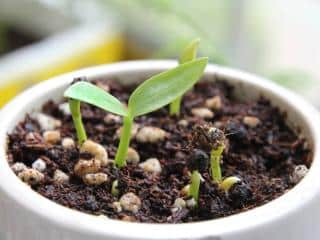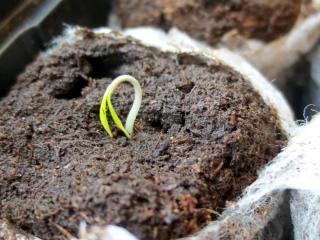

With immense pride, you’ve sown seeds for either a veggie patch or a showy garden. A steady shower of water brings forth the first timid shoots. But –wait– those young sprouts don’t look so good! They’re feeble, soft… probably suffering from damping off!Let’s talk solutions and explanations.
→ Get technical: understand damping off
Seedling blight, or damping, is a fungal disease caused by either of these fungi: Fusarium, Rhizoctonia, Pythium, Botrytis or Phytophthora. These fungi weasel their way into the plant’s core and start wreaking havoc. The poor seedling, too young to fend off such a disease, withers away in hours. Before you know it, all your seedlings are under attack, so speed is of the essence!
More worrying is that these fungi live everywhere: in soil, potting mix, and even on seeds themselves.
 Plant goes limp, lays down on the ground.
Plant goes limp, lays down on the ground.Every plant can suffer from this disease, be it herbs, flowers, or veggie seeds.

If sowing in a greenhouse, remember to air it out often, especially during a rainy spring.
Avoid dense, deep sowings. Sow in loose soil that you’ve worked through beforehand, using a broadfork if it’s in open ground or with well-draining seed compost mixed with sand. Also steer clear of excessively rich substrates.
Today, there are no natural curative treatments, only prevention methods. Disease spreads so fast that, if you spot it, best just toss affected seedlings away.
Fermented horsetail tea is an effective antifungal used in spraying. It’s a concentrate that needs dilution: 1 quart of manure for 9 quarts of water (1L manure for 9L water). Simply spray it on seedlings when watering. You can use a hand sprayer to mist seedlings with your tea. Don’t use it for each watering, only once a week, during germination. The rest of year, a monthly spray is enough for all your plants.

Antibacterial and antifungal, garlic is another natural ally against damping-off. Use it like fermented horsetail tea, in spraying. To make this infusion, simply put 1 lb of chopped garlic in 1 gallon of water (500g in 5 liters). Bring to a boil, then let simmer for 30 minutes. Then, turn off the heat, cover the container and let it sit for half a day. All that’s left is to filter and pour this solution into jugs and bottles.
→ Also worth learning about: